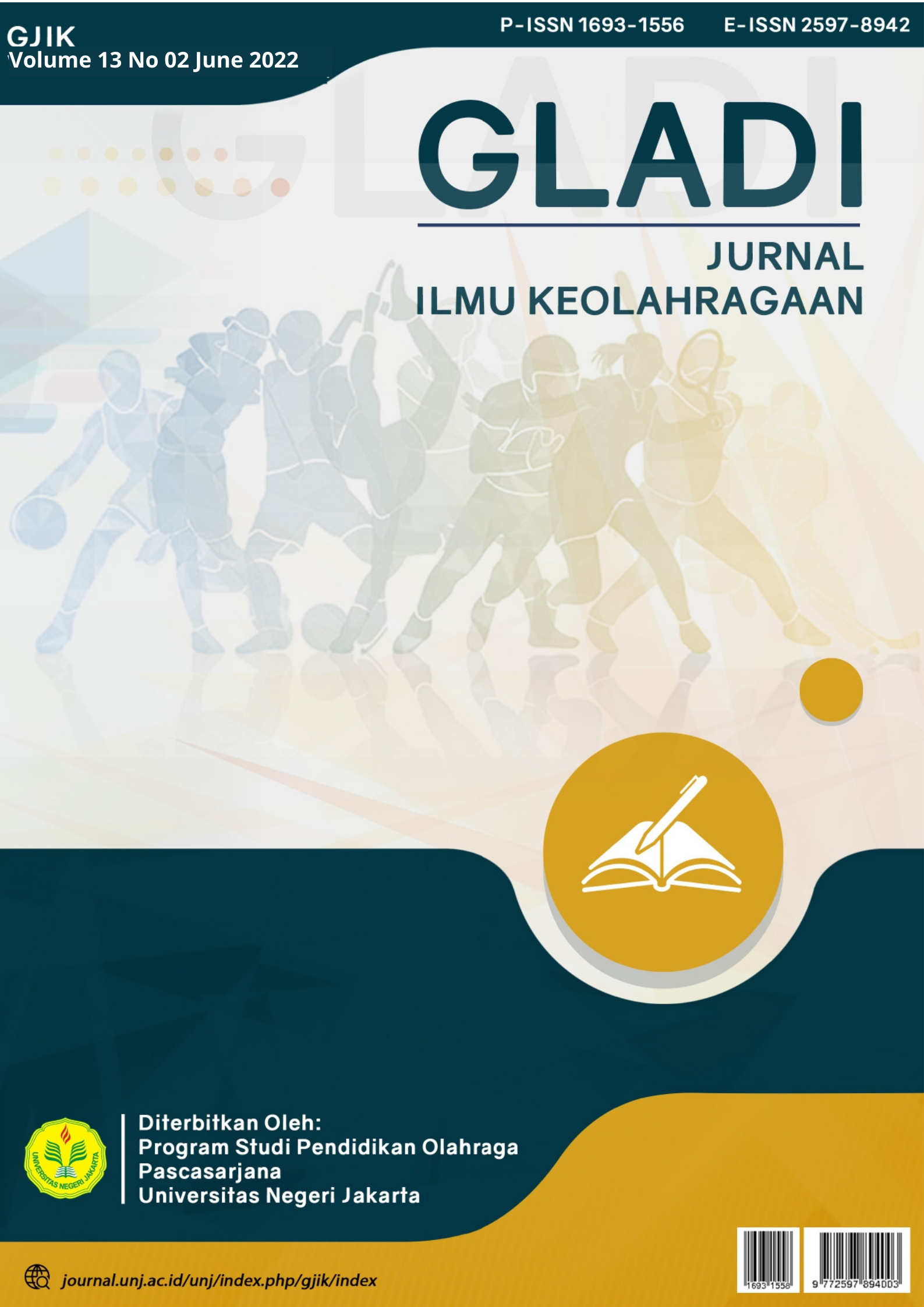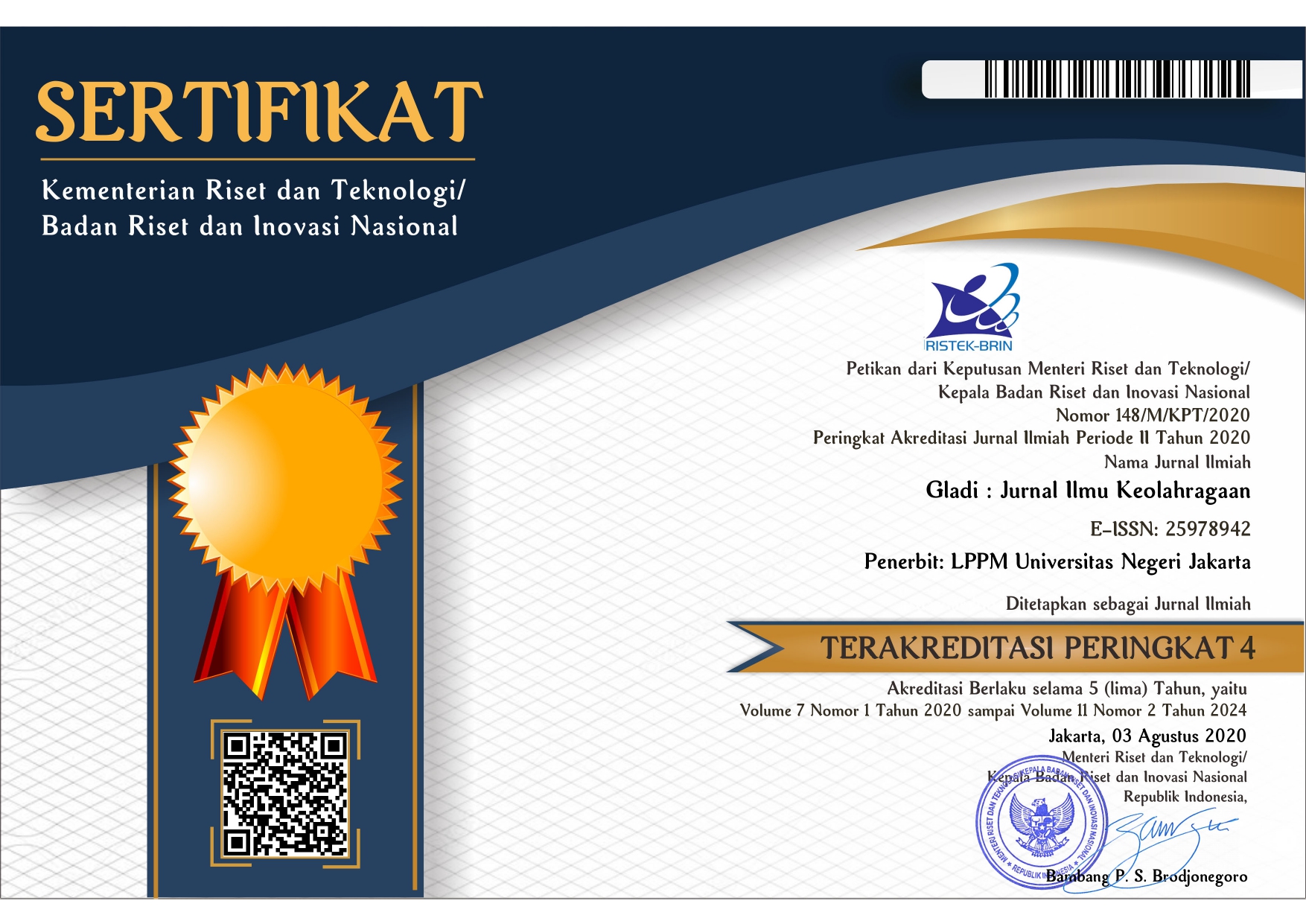The effect of outdoor education games with motivation level on student's physical fitness
Keywords:
outdoor education, motivation, physical fitnessAbstract
This study aims to determine whether outdoor education games have an effect on increasing students' fitness with motivation. The research method used is an experimental method with 2x2 factorial, this research was conducted at SDN 2 Jatimunggul, Terisi District, Indramayu Regency with the samples collected were students of class V and VI SDN 2 Jatimunggul. The data analysis used in this research is the two way ANOVA test and the Tukey test with the help of the SPSS application. The results of this study are outdoor education games have an effect on increasing students' physical fitness, there is an interaction between outdoor education games and the level of motivation on students' physical fitness, fortified outdoor education games are better used than moving bomb games to increase physical fitness in the high motivation group, while in In the low motivation group, there was no significant difference between the two outdoor education games on increasing students' physical fitness
Downloads
References
Fraenkel, J. R., Wallen, N. E., & Hyun, H. H. (2013). How to Design and Evaluate Research in Education. In McGraw-Hil (Vol. 53). https://doi.org/10.1017/CBO9781107415324.004
Hofferth, S. . (2008). American children’s outdoor and indoor leisure time. In E. Goodenough (Ed.), A place for play. A companion volume to the Michigan television film “Where do the children play?” Elsevier, 41–44.
Howe, C. A., Freedson, P. S., Alhassan, S., Feldman, H. A., & Osganian, S. K. (2012). A recess intervention to promote moderate-to-vigorous physical activity. SHORTCOMMUNICATION, (5), 82–88. https://doi.org/10.1111/j.2047-6310.2011.00007.x
Kirkham-King, M., Brusseau, T. A., Hannon, J. C., Castelli, D. M., Hilton, K., & Burns, R. D. (2017). Elementary physical education: A focus on fitness activities and smaller class sizes are associated with higher levels of physical activity. Preventive Medicine Reports, 8(May), 135–139. https://doi.org/10.1016/j.pmedr.2017.09.007
Koplan, J. P., Liverman, C. T., & Kraak, V. . (2015). Preventing Childhood Obesity: Health in the Balance. Institute of Medicine (U.S.).
Little, H., & Wyver, S. (2008). Outdoor play: Does avoiding the risks reduce the benefits? Australian Journal of Early Childhood, 33(2), 22–40.
Marmeleira, J. F. F., Aldeias, N. M. C., & Medeira da Graça, P. M. dos S. (2012). Physical activity levels in Portuguese high school physical education. European Physical Education Review, 18(2), 191–204. https://doi.org/10.1177/1356336X12440022
Mulya, G., & Lengkana, A. S. (2020). PENGARUH KEPERCAYAAN DIRI, MOTIVASI BELAJAR TERHADAP PRESTASI BELAJAR PENDIDIKAN JASMANI. Jurnal Pendidikan Kepelatihan Olahraga, 12(2), 83–94.
Mahendra, A. (2004). Azas dan falsafah pendidikan jasmani. Jakarta: Depdiknas.
Office for Standards in Education. (2013). Taking the first step forward ... towards an education for sustainable development: Good practice in primary and secondary schools. Retrieved from http://dera.ioe. ac.uk/4778/1/Taking_the_first_step_forward_towards_an_education_ for_sustainable_development.pdf.
Prastyo Kurniawan, A. (2017). Penerapan Model Pembelajaran Dengan Pendekatan Bermain Terhadap Peningkatan Keterampilan Gerak Dasar Dalam Pembelajaran Pendidikan Jasmani, Olahraga Dan Kesehatan (Studi Pada Siswa Putra Kelas Vii Smp Negeri 1 Balongpanggang Gresik). 4(1).
Prayogi, T. (2014). Implementasi Sarana dan Prasarana Penjasorkes Terhadap 7 Komponen Dasar Penjasorkes. Jurnal Pendidikan Olahraga dan Kesehatan, 2(1).
Safari, I. (2010). ANALISIS UNSUR FISIK DOMINAN. 40(November), 157–164.
Safari, I., & Saptani, E. (2019). Metode latihan dan koordinasi mata tangan meningkatkan akurasi forehand sidespin service tenis meja Method of exercise and hand-eye coordination improves the accuracy of the forehand sidespin table tennis service. 7(2), 174–181.
Sallis, J. F., Mckenzie, T. L., Beets, M. W., Beighle, A., & Erwin, H. (2012). Physical Education ’ s Role in Public Health Physical Education ’ s Role in Public Health : Steps Forward. Research Quarterly for Exercise and Sport, 38(August 2013),125135.https://doi.org/10.1080/02701367.2012.10599842
Scruggs, P. W. (2007). Quantifying Activity Time via Pedometry in Fifth- and Sixth-Grade Physical Education. 215–227.
Scruggs, P. W. (2013). Quantifying Physical Activity in Physical Education via Pedometry : A Further Analysis of Steps / Min Guidelines. 734–741.
SHAPE America. (2013). Comprehensive School Physical Activity Programs : Helping All Students Achieve 60 Minutes of Physical Activity Each Day Comprehensive School Physical Activity Programs ( Cont .). (703), 1–13.
Stone, M. . (2009). Smart by nature. Berkeley, CA: Center for Ecoliteracy.
Taufik, A., Subarjah, H., Supriyadi, T., & Fauzi, R. A. (2017). Pengaruh Kegiatan Pembelajaran Outdoor Education Terhadap Sikap Kemandirian Siswa Dalam Pendidikan Jasmani. SpoRTIVE, 1(1), 171-180.
Triana, M. N., Safari, I., & Akin, Y. (2018). Pengaruh Pembelajaran Dengan Model Bermain Terhadap Kemampuan Melempar Bola Pada Anak Tunagrahita Dalam Permainan Bocce. SpoRTIVE, 1(1), 581-590.
USDHHS. (2010). Strategies to improve the quality of physical education. Retrieved from. http://www.cdc.gov/HealthyYouth.
Widiyatmoko, F. A., & Hudah, M. (2017). Evaluasi Implementasi Pendidikan Nilai Dalam Pembelajaran Penjas. Jurnal Ilmiah Penjas (Penelitian, Pendidikan dan Pengajaran), 3(2).







